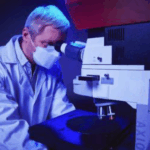The diversity of animal color vision exemplifies the remarkable adaptability of sensory systems through evolution. While many mammals, such as canines, exhibit dichromatic vision with limited chromatic range but enhanced scotopic sensitivity, other taxa display extraordinary photoreceptive capabilities. Avian species, for instance, typically possess tetrachromatic vision, extending into the ultraviolet (UV) spectrum, facilitated by four distinct cone photoreceptors. Even more complex are stomatopods (e.g., mantis shrimps), which may have up to twelve photoreceptor classes, enabling the perception of spectral and polarization cues far beyond human capabilities. Such interspecific variation in visual systems reflects the ecological and behavioral demands placed upon each organism, offering insights into how sensory modalities evolve to support survival and reproduction.
The Role of Microspectrophotometry in Vision Science
Microspectrophotometry (MSP) is a high-resolution analytical technique used to quantify the optical absorbance properties of individual photoreceptor cells and associated ocular media. By measuring the absorbance spectra of visual pigments in photoreceptors, MSP enables direct determination of an organism’s spectral sensitivity. This method allows researchers to assess the range of wavelengths that can be detected, including those in the UV region, which are invisible to the human eye.
MSP is particularly valuable in comparative and evolutionary vision science, as it provides empirical data on photoreceptor spectral tuning. These data inform our understanding of visual ecology, such as how animals detect mates, predators, or food, and how visual systems have adapted to specific environmental light conditions.
Case Study: Trichromatic Vision in Habronattus pyrrithrix
A notable application of microspectrophotometry is seen in the study of Habronattus pyrrithrix, a species of jumping spider. Researchers employing a CRAIC Technologies microspectrophotometer discovered that this arachnid exhibits trichromatic vision, utilizing photoreceptors sensitive to ultraviolet, green, and red wavelengths. Such complexity in a spider visual system is rare and reveals a nuanced capacity for chromatic discrimination, likely linked to sexually selected behaviors such as courtship display, as well as environmental navigation and prey detection. This study illustrates how MSP can uncover fundamental aspects of visual system evolution and behavior.
Principles and Methodology of Microspectrophotometry
Microspectrophotometry involves directing broadband light through microscale biological samples—typically isolated photoreceptor cells or ocular tissues—and recording the absorbance at each wavelength. The resulting absorbance spectrum reflects the spectral sensitivity of the visual pigment present in the sample. By integrating these data with knowledge of lens and vitreous transmission, researchers can reconstruct the effective spectral range reaching the retina and evaluate the functional visual capacity of the organism.
This technique has been essential in mapping spectral sensitivity curves across a wide array of taxa, thereby elucidating how photoreceptor complement and ocular filtering properties shape visual perception in ecological and evolutionary contexts.
Broader Implications of Color Vision Research
Understanding the mechanisms and diversity of animal color vision has far-reaching implications beyond basic biology:
-
Behavioral Ecology: Color perception underpins critical behaviors such as mate selection, predator avoidance, and foraging strategy. MSP enables the quantitative assessment of these perceptual abilities in natural contexts.
-
Conservation Biology: Insights into species-specific visual systems can inform habitat design, light pollution mitigation, and wildlife corridor planning to better align with sensory ecology.
-
Bioinspired Technology: Research into animal vision has inspired advances in optical sensors, imaging systems, and machine vision technologies. Mimicking biological photoreception may lead to innovations in areas such as autonomous robotics and biomedical diagnostics.
References & Further Reading
- Zurek, Daniel & Cronin, Thomas & Taylor, Lisa & Byrne, Kevin & Sullivan, Mara & Morehouse, Nathan. (2015). Zurek Morehouse 2015 Supplement.



